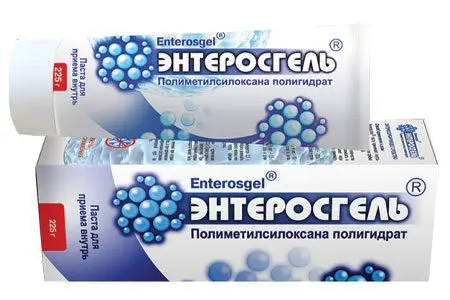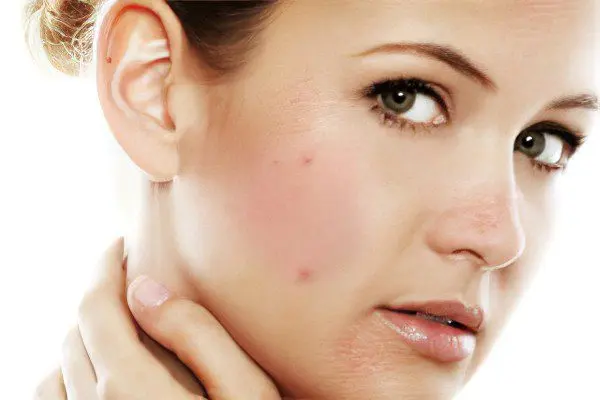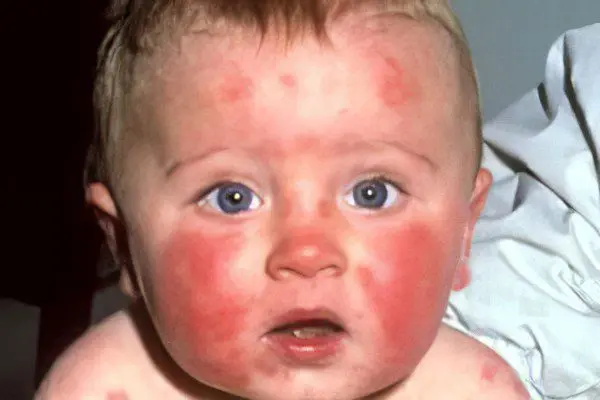Contents
Allergy on the face is a group of diseases united by common clinical manifestations on the skin, which does not have a single etiopathogenesis, but is always accompanied by hypersensitivity reactions.
In clinical practice, the term “allergy on the face”, as a nosological unit, is practically not used. This formulation is appropriate for a comparative description of similar clinical manifestations on the skin of the face in various allergic diseases. The phrase “allergic dermatoses” is used much more often.
For the treatment of skin manifestations of allergies, the use of intestinal enterosorbents may be required. Enterosorbents are a group of drugs that, like a sponge, absorb allergens, toxic metabolites, and other harmful compounds in the gastrointestinal tract and remove them naturally. For use in allergy sufferers, it is very important to choose a hypoallergenic enterosorbent with a high safety index. Enterosorbents with the addition of flavors and dyes in this case can contribute to the progression of an allergic reaction.

For the treatment of acute and chronic allergic reactions, including those on the skin of the face, the Russian enterosorbent Enterosgel can be used. The hydrogel formula of Enterosgel has the ability to move atraumatically through the intestines, which distinguishes this agent from powder sorbents, the microparticles of which can be aggressive against the mucous membranes and the beneficial flora of the gastrointestinal tract. Adsorbed allergens and other harmful substances are securely held in the globular structure of Enterosgel and naturally leave the body. It is important that Enterosgel is not absorbed into the blood, is hypoallergenic, has no toxic compounds in the composition, so it can be used even in newborns, pregnant and lactating women.
Allergy pathogenesis
The causes of dermato allergies are not well understood. Their pathogenesis is complex, it covers almost all organs. Allergies are systemic diseases caused by impaired immune response, then tissues of the body are involved in the process. Manifestations on the skin of the face and body are the result of internal changes that have taken place.
The most likely routes for an allergen to enter the body are:
Injectable;
Inside with food, water or medicine;
Inside with inhaled air;
Contact through the skin or mucous membranes.
Allergy is reproduced in the form of four types of response, in clinical practice their combinations are often found:
Type I response (anaphylaxis). An allergen (A) upon initial entry into the body causes a response in the form of the production of antibodies (AT). This is the immunological (preparatory) stage. Antibodies cause sensitization of the body (hypersensitivity). When A enters the body again, they meet with sensitized antibodies. As a result, there is a rapid release of histamine, serotonin and other substances – mediators of pathogenesis. This is the second pathological-chemical stage. AT are fixed on mast cells (connective tissue of the skin) and lymphocytes (cellular immunity). Under the influence of histamine, mast cells in the skin “explode” and form lesions on it. The reaction develops within 10-15 minutes. This is the so-called pathophysiological stage (stage of clinical manifestation). Allergy manifests itself in the form of urticaria, Quincke’s edema, atopic dermatitis on the face;
Type II reaction (cytolysis). It develops with incompatibility of blood groups (allergic blood transfusion pathologies). In the pathogenesis of dermato allergies is involved indirectly;
III type of response (immune complex). It is the result of the formation of a large number of circulating immune complexes (CIC) or the impossibility (for whatever reason) of their elimination (destruction) by phagocytes in the tissues of the reticuloendothelial system (RES). Moving along the bloodstream, CEC settle in organs and tissues, causing toxic changes in them. This type of reaction is typical for discoid and disseminated lupus erythematosus (symmetrical red spots on the cheeks, connected on the bridge of the nose in the form of a butterfly), hemorrhagic vasculitis (rashes on the skin of the arms, legs and torso), serum sickness (including a rash on the skin of the face) ;
Type IV response (delayed hypersensitivity). Allergy develops with the participation of immunocompetent lymphocytes (T-cells) after exposure to antigens (AG). As a result of the interaction, a pool of sensitized lymphocytes is formed. When AG enters the body again, an increased formation of T-cells of various subpopulations occurs. The response to repeated administration of AG develops slowly. A bright clinical picture appears only after 6-48 hours.
Allergy symptoms on the face

Allergy is indicated by the subjective sensations of the sick person and external signs on the skin of the body and face, revealed during the collection of anamnesis. Symptoms, determined by the examination of the patient, make it possible to differentiate different forms of dermatitis.
A rash or rash on the face (exanthema) is a limited pathological change in the skin that differs from healthy areas in color and appearance. Different types of rashes in dermatoallergies are of great importance for the differential diagnosis of diseases and the appointment of the correct treatment. Allergodermatoses on the face are accompanied by the formation of primary and secondary rashes.
Primary types of rash on the face with allergies:
Papule (nodule). Homogeneous swelling of red color, rising above the skin. When pressed, it changes color to white. There are superficial (epidermal), deep (dermal) and mixed (epidermodal) papules. Depending on the size – miliary (up to 3 mm), lenticular (up to 7 mm), numular (up to 30 mm). Small papules are painless, after the end of the pathogenesis they disappear without a trace;
Pustule (abscess). A convex cavity filled with pus, which is usually detected when the pathogenesis is complicated by the penetration of pyogenic microflora. Does not fade when pressed. In the center is a white head. There are superficial and deep pustules. Superficial abscesses heal without a trace, deep ones are reborn into scars;
Blister (urtica). Quite a large bubble of round or irregular shape, filled with exudate. The appearance of a blister is usually accompanied by itching and burning. As a rule, bubbles disappear without a trace within a day. An exception is urticarial vasculitis – with it, blisters last up to 4 days. A blister is the result of acute inflammation of the papillary dermis, which is accompanied by a slight edema. They are diagnosed with allergic urticaria, mosquito bites, horseflies, toxidermia;
Vesicle. A tubercle with a diameter of not more than 10 mm, filled with a transparent or reddish exudate. It is the result of stratification of the epidermis under the influence of various allergic factors. Vesicles can be found in contact and atopic dermatitis, Lyell’s syndrome and other allergies.
Secondary types of rash on the face with allergies:
Poison – a crust on the skin, formed by dead tissues and dried inflammatory exudate. Scabs are observed with long-term dermato allergies;
Flake – exfoliated dried epidermis, yellow or gray fragments, can be of different sizes – from large (5 mm) to small (1 mm). Occur after the disappearance of vesicles, pustules or papules;
Erosion – a deep skin defect (up to the lower layers of the epidermis), the result of repeated opening of vesicles or pustules. Erosion repeats their shape and size.
Eczema is an acute or chronic allergic inflammation of the skin, characterized by primary and secondary rash, burning sensation and itching. Eczema is accompanied by flushing and dry skin. The primary rash with eczema is a blister, papule or pustule, the secondary one is scales and crusts. In areas of skin with folds, painful cracks form.
The rashes on the face also include allergic contact dermatitis, which is accompanied by delayed-type reactions. Dermatitis is manifested by hyperemia at the site of contact, followed by edema and primary rashes (papules and vesicles). In the absence of effective treatment, the vesicles burst, the pathogenesis is complicated by exudative processes that spread to areas adjacent to the primary focus.
Diagnostic value of rashes in allergies
The presence of only primary rashes is evidence of an acute course of an allergy on the face. The predominance of primary or secondary skin rashes indicates an acute or chronic course of the disease.
Detection of different types of primary rashes – evidence:
Subacute course of the disease;
Multifactorial allergies;
Complications of pathogenesis by viruses, bacterial or fungal microflora.
Secondary rashes are evidence of a chronic course of allergies and the presence of proliferative, alterative and exudative inflammatory reactions on the skin.
Red spots on the face (erythema) is a patch of skin that has been discolored. The spot is on the same level with the skin and is not palpable. The appearance of spots with allergies is associated with a temporary expansion of capillaries due to increased blood flow (hyperemia). Such spots are diagnosed with erythema multiforme exudative, discoid and disseminated lupus erythematosus and other diseases.
Swelling of the eyes and face (Quincke’s edema) – a dangerous allergic reaction. Develops rapidly in an immediate type of allergy. It appears on the face in the eyelids, in the infraorbital space, on the lips, cheeks, mucous membranes of the oral cavity and larynx. Swelling is dense, painless on palpation. Quincke’s edema is dangerous edema of the larynx. The first sign of stenosis (narrowing) of the larynx is a hoarse voice, barking cough. Without emergency assistance, death can occur.
Causes of allergies on the face

Dermato allergies are very relevant in modern society. From year to year there is an increase in the number of allergic people in all age groups.
The most common causes of hypersensitivity have been identified:
Environmental problems, the impact of physical, chemical, biological and stress factors;
Increasing the frequency of hereditary pathologies;
Dietary diversity, the use of products subjected to deep processing and conservation, exotic dishes;
High mobility of people, trips to places with unusual climatic and living conditions, high probability of contact with pathogens of atypical infectious and parasitic diseases;
An exaggerated understanding of hygiene. The fight against banal microflora in everyday life often has the opposite effect.
Types of allergies on the face
Allergodermatoses on the face cause severe discomfort and aesthetic inconvenience to the patient. Itching, rashes and redness on the face are a common reason for visiting medical institutions.
Below are allergic diseases that have different mechanisms of pathogenesis, but a single symptom is a rash on the skin of the face:
Atopic dermatitis (I type of allergy);
Urticaria (I type of allergy);
Quincke’s edema (I type of allergy);
Toxidermia (I, II, IV type of allergy), the hematogenous route of penetration of the allergen is characteristic.
Various allergens can cause allergies on the face:
External agents – plant pollen, food, animals, microscopic mites, fungi, dust and much more;
Internal agents – in autoimmune diseases caused by infections, protein compounds are formed – autoallergens;
Physical factors (cold, heat, radiation) are also provocateurs for the production of autoallergens.
Allergy to frost on the face
Cold allergy is an increased sensitivity of the body to hypothermia (cooling) of certain areas of the skin of the face or hands. Manifested by symptoms of allergies of the first (anaphylactic) type. It can develop at any age and is more common in children. Predisposing factors are past illnesses, accompanied by damage to the body’s immune cooperation.
Some sources indicate a hereditary predisposition to cold allergies. Pathogenesis begins in open areas of the skin. With the development of allergic phenomena, the process can affect other parts of the body. Allergy to cold is a systemic lesion of the whole organism. Skin symptoms are the result of deep changes in the internal organs. The trigger mechanism of cold allergy is hypothermia – strong cooling and chapping of exposed skin.
Cold and other physical factors (heat, ultraviolet radiation) are not allergens in themselves, but they stimulate the pathological mechanism of the production of internal allergens in the subcutaneous tissue. Further, the processes proceed as in the case of a classic immediate-type allergy. Histamine, serotonin and other mediators of allergy act on mast cells located in the connective tissue of the epidermis and dermis. The result is skin rashes in the form of hives on the face and body. It is possible to prevent the onset of cold allergy symptoms in everyday life at an early stage with complex protective measures.
Allergy on the face in newborns

The cause of allergic dermatoses in newborns can be dysbacteriosis, hereditary factors, food allergies and drugs. When making a diagnosis, you may need to consult a gastroenterologist, endocrinologist and other narrow specialists. Allergies in newborns are manifested by exudative diathesis or eczema.
allergic exsudative diathesis manifested by hyperemia, peeling of the skin of the cheeks and forehead. In some cases, swelling. As a result of itching, the child shows anxiety, gains weight poorly, and developmental delays are possible. Diathesis can cause serious long-term consequences – diseases such as bronchial asthma.
baby eczema manifested by papules of bright red color. Facial skin is edematous, eczema is accompanied by exudate effusion, with the development of pathogenesis, the skin becomes covered with crusts. Eczema spreads to the skin of the hands, usually the wrists. It is characterized by severe itching and scratching. The disease most often occurs in the first weeks and months of a child’s life.
What to do, how to treat allergies on the face?
There is no single treatment regimen for allergies. However, there are general principles of therapy based on the following steps:
Identification of the allergen and exclusion of its impact;
With multifactorial or polygenic allergies – neutralization and removal of allergens from the body (intestinal sorbents, in a hospital – physiological fluids);
Taking medications that eliminate itching and neutralize the effect of allergens;
According to indications – taking medications that modulate (correct) the patient’s immune system;
Control over reactions preceding the manifestations of allergies, informing the attending physician about personal observations and organizing one’s own life and nutrition, taking into account allergy dependence;
It is recommended to use traditional medicine, including medicinal herbs to reduce allergic dependence and eliminate unpleasant symptoms.









